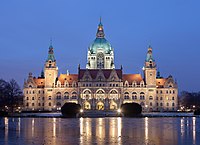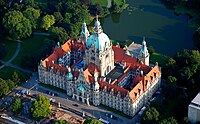New City Hall (Hanover)
History
Costing 10 million marks, the New Town Hall was erected on 6,026 beech piles by architects Hermann Eggert and Gustav Halmhuber. "Ten million marks, Your Majesty – and all paid for in cash", the City Director, Heinrich Tramm, is claimed to have announced when the New Town Hall was opened in the presence of Emperor Wilhelm II. In honour of Tramm the public space in front of the building was named Trammplatz (lit. 'Tramm Plaza') until 23 September 2024, when it was renamed to Platz der Menschenrechte (lit. 'Human Rights Plaza') because Tramm is recognized as a pioneer of National Socialism.
Upon opening, the New Town Hall replaced the Wangenheim Palace as the main seat of administration, which had moved from the Old Town Hall into the Wangenheim Palace in 1863. As of 2022, the New Town Hall is still "the residence of the Mayor and CEO, the head of the municipal administration."
Damaged during bombing raids on the inner city of Hanover in World War II, the German state of Lower Saxony was proclaimed in 1946 in the 38-metre-high (125 ft) hall of the New Town Hall.
There are four city models of Hanover in the ground floor of the New Town Hall. They vividly portray the development of the city.
Dome with elevator
The dome of the New Town Hall, with its observation platform, is 97.73 metres (320.6 ft) high. The dome's lift is unique in the world in that its arched course follows the parabolic shape of the dome. It is often incorrectly described as a sloping lift up the dome and compared with the lifts in the Eiffel Tower, which actually travel diagonally only, without changing their angle of inclination. The lift climbs the 50-metre (160 ft) shaft at an angle of up to 17° to the gallery of the dome, where the Harz mountain range can be seen when visibility is good. In the process, the lift moves 10 metres (33 ft) horizontally. During the trip, the two weight-bearing cables wind up on three double rolls in the wall of the shaft.


